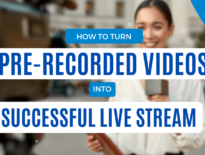VOD and live streaming are OTT (over-the-top) ways of delivering content. This means they are vdelivered through an internet connection and not through cable or satellite.

Live streaming is popular as it is ‘in the moment’ and uncensored. With high-powered mobile devices and fast internet, users want Netflix like Video-On-Demand (VOD) for your live stream.
There is a great room for growth in the video streaming market as video content especially live video content is becoming the norm.
Once a live stream ends, the use of live stream video does not have to stop there – you can save the stream and repurpose it for future use as VOD.
It is predicted live video will make up 82% of all internet traffic by 2022, and video-on-demand traffic will double during the same time.
Difference between Live Streaming, Linear TV and Video-On-Demand (VOD)

Live streaming, linear tv, and video-on-demand (VOD) are terms that may be used interchangeably, but they are technically different transmission methods that require use of different kinds of equipment and software.
Live streaming
Live streaming refers to video coming from an event as it happens in real-time. Think about broadcasting a video live while watching a football match or a tennis match as it’s happening.
People love the immediacy and authenticity of live streaming.
As live stream occurs only at an appointed time, the live stream video can not be consumed on-demand but streaming does help organizations to connect with an audience on a more personal level.
Live streaming is best used for events like product launches, conferences, webinars, live sports, and news. Making in-person events available for remote attendance with live streaming can significantly widen the reach of an organization.
Linear TV
Anyone who watches television has experienced linear TV. TV video and audio is streamed over-the-air, through the cable connected to the cable box or through the satellite dish on the roof.
This type of broadcasting offers a passive viewing experience. Content on linear tv is broadcasted to you and is consumed by viewers while switching through channels on their cable tv.
Linear tv is highly inflexible in this digital age. While cable tv has a wide reach all over the world, content on linear tv can hardly be curated to create personalized content for your audience as the linear tv content is built for mass audience consumption.
Video-on-demand (VOD)
Video-on-demand streaming (VOD) is one of the fastest-growing segments of streaming.
Sites such as Netflix, Amazon Prime and Hulu are all examples of VOD streaming. Users have the ability to search for video content that they want to watch and then click on video content as it does not play automatically in the way it does when you turn on a traditional TV.
It is possible to watch high-quality on-demand video wherever you have fast internet, both from your mobile phone and other devices.
You can choose what video you’re going to watch and when you’re going to watch it. Usage of media controls on a video that gives you complete control and allow you to play, rewind, pause or fast forward view at your pleasure.
Viewing video content on VOD is convenient and accessible and there’s no shortage of content to watch, including lessons, fitness programs, interviews, product demos and much more.
Automatically record your live stream using a video solution platform and convert it into VOD

Current popular live streaming apps include Facebook Live, Instagram Live stories, TikTok, and Twitch.
Some live streaming feeds can be private such as video conferencing calls which use live streaming technology to allow you to talk to specific people.
Other live streams may be watched by thousands of viewers and if you’re live streaming, you can invite as many people as you like to watch. The only limitation with live streaming is the server capacity of the streaming service you use.
Live streams that are broadcasted can easily be recorded and then converted to VOD using a video hosting solution. Video solutions like Cincopa natively-integrate with streaming solution like Zoom.
Your live stream once they are concluded are automatically uploaded to video hosting platform. Here are the steps that should be followed to convert your live stream to a VOD –
- Go to the asset page on your hosting platform and check that the recorded stream has been uploaded
- Open up the setting options of the video and edit the start & end of the stream
- Add annotation, branding (watermark), CTA, lead generation forms etc., to the video
- Use an appropriate template for your video gallery
- Add your live stream recorded videos to the template gallery
- Change settings to the gallery with your requirements
- Once videos have been added to the gallery. Set up tags, metatags to the gallery
- Your gallery is set with VOD videos
- Use the gallery embed option to copy and paste the code to your website
- Publish the landing page with the gallery embed code
It is easy to host a live stream even if you have little technical know-how. All you need is an internet connection, relevant video and equipment and a platform to stream from.
There’s a low barrier to entry with streaming, it’s time effective and it offers real-time interaction. That being said, setting up a live stream requires some technical skills and experience.
Producing a high-quality stream can be demanding and using professional video services will offer you many advantages.
Live streaming using a video solution platform

Live streaming is made easier for you when you use a video solution platform. The video streaming software allows you to deliver a high-quality video feed.
Here are the advantages of using a video hosting solution for your live stream –
A Content Delivery Network (CDN) with video hosting solution
A CDN offers advanced caching solutions to ensure excellent video delivery and make sure there’s no buffering. CDN servers are distributed globally and every viewer receives video content from the server closest to them to ensure they have a good viewing experience.
Without CDN support, your videos may not be playable in many locations worldwide. As so many employees work remotely today, this could be a serious problem. You need a live streaming service with a solid infrastructure and good CDN to achieve a high-quality feed.
Access to a powerful CDN is expensive and the cost can creep up because prices are usually determined by the amount of bandwidth you use.
Using a professional video hosting platform with access to a powerful CDN may save you money over long term.
Adaptive bitrate streaming with video hosting
Live streams use adaptive bitrate streaming to ensure smooth delivery and prevent buffering.
This technology enables the delivery of video to users in the most efficient way and in the highest usable quality for each specific user.
It allows video providers to create a different video for each screen size or device to ensure the viewer always receives a video that looks good. It also resolves buffering by ‘adapting’ to the speed of the user’s internet connection.
Transcoding for better viewing with video hosting solution
Passthrough streaming means that your feed is distributed as is with no platform-level optimization.
Using transcoded live streaming technologies means your content is converted on the go to be compatible across devices and browsers for a better user experience.
Monetization with the help of video hosting
If you’re wondering how you can make money from live streaming, many professional streaming services offer tools to help you. For instance, you can gate your live stream and have people pay to access it. Live streaming platforms also give you the option of monetizing with sponsored ads.
Converting your live streams into on-demand videos allows you to earn more. Do the work once and create valuable video assets that keep on generating income.
The subscription video-on-demand model (SVOD) offers viewers access to a video library for a recurring monthly or annual feel. Users can view the content they want to see from one platform without any distractions.
Automatically save live streams to your video library
Your live streams are your assets, and when your live streams are automatically saved to your video library, they won’t get lost.
Audiences that watch live streams have different expectations than when they consume VOD. They’re more forgiving and don’t expect a perfect presentation with a live stream.
However, for VOD, audiences have more expectations with regard to factors like quality and presentation. This is why you need to enhance your video content once you’ve saved it.
Repurpose your live stream with video hosting
Post-production of a live stream is where editing happens and you can work on making your live stream videos work as VOD.
There are various digital tools you can use to do this. Here are some ideas of how to repurpose your live stream:
- Make a highlight reel of a live stream by editing it to exclude anything unnecessary.
- Post a teaser video of your live stream on social media to get people to watch a replay.
- Make your live stream into a podcast by converting it to audio and editing it.
- Make a compilation of highlights from several old live streams.
- Don’t forget to collect all the comments you receive on your live stream, too, as these will give you insight into your customers. You could use the questions to create helpful answers with links to further information.
Enhance your videos with video hosting
It is possible to enhance videos with various features such as annotations, CTAs, and subtitles.
When you add annotations, you can further engage with your audience without interrupting the video. A CTA encourages users to take different actions, such as visiting a landing page, signing up for a newsletter and more. Adding titles and descriptions will also boost your videos in web search.
You can make your video content accessible to viewers all over the world by adding subtitles and closed captions in different languages.
Consider dividing the content up into shorter sections that are easier to watch and create the type of thumbnail that will attract viewers.
You can also easily add an email collection form to your videos. Once you’ve enhanced your video content, you can embed it on your website and use it for your marketing campaigns.
Offer users flexibility
VOD offers an effective online asset for your brand. You can deliver value to your users for much longer than the short duration of a live stream.
Viewers have the flexibility of watching videos from anywhere at any time and on any device. You can create an entire video library that’s accessible to your users and leverage your videos effectively for marketing and many other purposes with VOD.
Drawbacks of live streaming
While live streaming is a popular method of reaching a wide variety of audience with your video content, though there are drawbacks to live streaming method. Let’s look at one of them –
Technological complexities of live streaming
Live streaming is technologically complex method as data must be sent to the video player of the viewer in such a way as to minimize delays between transmission and reception of the streaming data.
Video players sometimes can’t cache large amounts of content.
If users have a poor internet connection and can’t download the video stream quickly enough, the video needs to pause and wait for data before starting again.
This situation is common with live streaming, especially on mobile devices, where the connection can vary considerably depending on the location. This buffering and low video content on live stream is very frustrating for viewers and sometimes can lead to disastrous results.
Why your should save your live stream and upload it to your website?

One of the downfalls of using free streaming services is that viewers can have many distractions that take away from their experience.
Using YouTube or Facebook Live can lead to a loss of traffic and revenue for your organization. Following are the reason you should upload your live streaming content to your website –
Undivided viewer attention
Features like ‘related videos’ on YouTube are designed to keep viewers watching.
Viewers easily hop from one video to the next and that takes them away from your videos.
You want to rather encourage viewers to support your brand and keep watching your videos. Unrelated videos, third-party logos and advertisements clutter the screen and prevent attention from remaining on your live event when you use free streaming services.
Customizable video player
If you use a professional video hosting service, your HTML5 video player will be customizable.
You can not only promote your brand by using your own logo and colors but you can also select functional elements of the player and make decisions about buttons and controls. Being able to customize a video players appearance also means that you can integrate it more seamlessly on your website.
All of these seemingly small factors offer a more professional look that promotes your brand image.
Complete control over your video assets
Using a video hosting solution means you have complete control over your video assets.
There’s no chance of Facebook or another platform suddenly banning or demonetizing your channel due to a change in guidelines. These sudden decisions have hurt many businesses.
You want your video assets to remain yours and yours alone. By uploading video content to your website, means the video asset is completely under your control and not a third-party website.
Implement VOD on your website with a video hosting platform

When you save your live stream, you can repurpose it into on-demand content to maximize your viewership with a video hosting platform.
With a video hosting platform, you can repurpose your video content in many ways and keep it all together so you can showcase it on your website.
Here are the enterprise features that you can get from a video hosting platform to better use your video assets on a website –
Manage your digital assets easily
Today enterprises often work with thousands of videos and this is where digital asset management comes into play.
You need a modern digital asset management (DAM) system if you work with many videos, especially long ones like a lengthy training session or an hour-long recorded live stream. It is expensive to store videos and to manage them can be difficult.
Using a video hosting platform that offers digital asset management can be invaluable. It will enable you to view, organize, edit and analyze all your video assets from a single dashboard.
Drive more traffic with video SEO
People won’t see your videos unless you make them easy to find when they search.
Using a video hosting platform enables you to benefit from video SEO-friendly embed codes that encourage search engines to rank your content higher.
Modifying and optimizing the metadata of your videos makes them more searchable for relevant keywords on a search engine like Google.
Help viewers to find the video content they want
There are also various ways you can improve the time it takes for people to find the right video. When you enable automatic transcription and use auto-tagging, this improves search.
You can also make search filter functionality more relevant when you can assign custom identifiers like course titles or lecture numbers.
Using chaptering to break your videos up into chapters helps them to access the content they want to see most.
Integrate with your existing systems
Video API access allows you to customize your video hosting experience by integrating with your other systems, such as a CRM or Learning Management System.
This is much better than keeping your videos in silos unconnected to your other systems. For instance, you can use videos very effectively in your email campaigns where they can generate three times the click-through rate.
Handle security threats
A DAM system must also be able to handle modern security threats with features like encryption, role-based access control and limited sharing of highly confidential internal videos.
When users have to download videos to watch them because systems cannot handle optimized playback, they are no longer protected by a security layer and they can fall into the wrong hands.
Get access to advanced analytics
You need to track the success of your live streaming in terms of viewership and viewer behavior. Tracking tools and video analytics dashboards can help you to evaluate the outcomes. Relevant metrics are more than just viewer numbers.
When it comes to VOD, you want to know how much of video viewers watched, which parts engaged them most and which parts they skipped. Knowing how viewers engage means you understand them better and you can effectively target them.
Video analytics offered by video hosting platform is the way to understand the imapct of your videos on audiences.
Customer support
Using a free streaming service often means you receive very little customer support, whereas the best paid live streaming services provide customer support 24/7.
It can be tricky to deal with technical issues when you don’t have much live streaming experience. It helps when you know you can receive assistance if you run into difficulties.
Conclusion
It is crucial for organizations to efficiently manage their valuable video assets.
Live streaming is becoming increasingly popular and offers the potential to reach thousands at the click of a button. It’s not over when you stop your live stream because you can repurpose video content in VOD to gain more from your efforts.
Both live streaming and video-on-demand offer different benefits. The question is how to leverage them best to suit your business purposes.
Using a combination of both live streaming and VOD will help you to impress your customers and generate more revenue.









